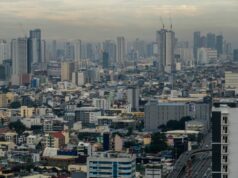BSP sees July inflation settling at 0.5% to 1.3%

By Luisa Maria Jacinta C. Jocson, Senior Reporter
THE BANGKO SENTRAL ng Pilipinas (BSP) on Thursday said it expects headline inflation to settle below 2% in July.
The central bank’s month-ahead forecast showed that inflation likely fell within the 0.5%-to-1.3% range in July. If realized, July inflation would be slower than the 1.4% print in June and the 4.4% clip a year ago.
“Upward price pressures for the month are likely to be driven by higher meat and vegetable prices partly due to unfavorable weather conditions, increased electricity rates, elevated domestic fuel costs, and the depreciation of the peso,” it said.
Manila Electric Co. (Meralco) hiked rates by P0.4883 per kilowatt-hour (kWh) in July, bringing the overall rate for a typical household to P12.6435 per kWh from P12.1552 per kWh a month earlier.
The peso fell to P58.32 against the greenback at end-July from its finish of P56.33 at end-June. The peso’s close at end-July was its weakest in almost six months or since its P58.34 finish on Feb. 4.
“These price pressures, however, could be partially offset by the continued decline in rice prices,” the BSP added.
Rice inflation has been steadily declining for the past few months amid several government interventions for the staple grain. In June, rice inflation contracted for the sixth straight month to a record 14.3%, the biggest drop since 1995.
“Going forward, the BSP will continue to monitor developments affecting the outlook for inflation and growth in line with its data-dependent approach to monetary policy decision-making.”
The local statistics agency is set to release the July inflation data on Aug. 5 (Tuesday).
IMF FORECAST
Meanwhile, the International Monetary Fund (IMF) projects Philippine headline inflation to settle below 2% this year, giving the central bank more space to ease policy rates further.
Following the release of its World Economic Outlook (WEO), the IMF said it expects inflation to average 1.8% this year, below the central bank’s 2-4% target.
“The headline inflation projections have been revised down by 0.8 percentage point (ppt) and 0.6 ppt for 2025 and 2026 respectively, reflecting lower-than-expected inflation outturn in the first half of 2025,” an IMF spokesperson said in an e-mail.
Headline inflation picked up to 1.4% in June from 1.3% in May but slowed from 3.7% a year ago. This brought the six-month average inflation to 1.8%.
The BSP expects inflation to average 1.6% this year.
Risks to the inflation outlook are “broadly balanced,” the IMF said, but cited risks such as higher commodity prices due to escalating geopolitics, supply-chain disruptions and climate shocks, among others.
For 2026, the multilateral institution sees inflation settling at 2.3%, lower than the BSP’s 3.4% forecast.
With inflation expected to be well-contained, the central bank can continue its rate-cutting cycle.
“Monetary policy has room to be more accommodative amid a benign inflation outlook,” the IMF said.
The central bank has been on an easing cycle since August last year, lowering borrowing costs by a total of 125 basis points. This brought the benchmark to 5.25%.
BSP Governor Eli M. Remolona, Jr. has said a rate cut is still on the table at the Monetary Board’s Aug. 28 meeting.
“Amidst prevailing uncertainty and with two-sided risks to inflation, a data-dependent approach, and clear and effective communication around policy settings will be important to manage expectations.”
UNCERTAINTY PERSISTS
Meanwhile, the IMF said its latest gross domestic product (GDP) projection for the Philippines this year reflects the impact of “recent global trade policy conflicts and elevated policy uncertainty.”
In its latest WEO, the IMF maintained its 2025 growth forecast for the Philippines at 5.5%. This would fall at the lower end of the government’s 5.5-6.5% target for the year.
“Real GDP growth forecast for 2025 is unchanged relative to April WEO reflecting offsetting effects from higher growth in trading partners contributing positively, and lower-than-expected first-quarter outturn and higher energy prices contributing negatively.”
The IMF had also raised its 2026 projection to 5.9% from 5.8% previously, citing “robust consumption and an increase in investment, which will be supported by monetary policy easing.”
“The forecast for 2026 reflects a positive contribution from smaller-than-expected consolidation in 2026 as announced in the authorities’ revised Medium Term Fiscal Framework.”
At its June meeting, the Development Budget Coordination Committee revised its fiscal program to account for external factors.
The government is now aiming to bring down its deficit to 4.3% of GDP by 2028, versus its previous target of 3.7%.
The growth outlook for next year is also expected to be partially offset by a “higher impact of uncertainty on private demand” that was initially priced in during the April forecasts, it added.
Meanwhile, the IMF said that downside risks to growth include escalating trade measures, prolonged uncertainty and geopolitical tensions.
“Extreme climate events and other natural disasters also constitute downside risks.”
“On the upside, accelerated implementation of structural reforms and a reduction in infrastructure gaps can contribute to higher growth over the medium-term,” it added.



